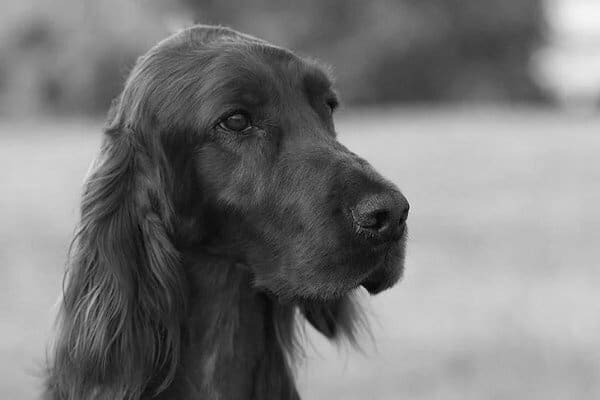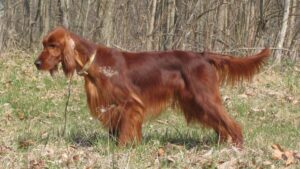
The Dual Irish Setter: The Essence of the Breed
Explore the Irish Setter’s dual nature excelling in show and field, highlighting the breed’s resurgence in Dual Championship titles.
Home » Meet The Breeds » Irish Setter


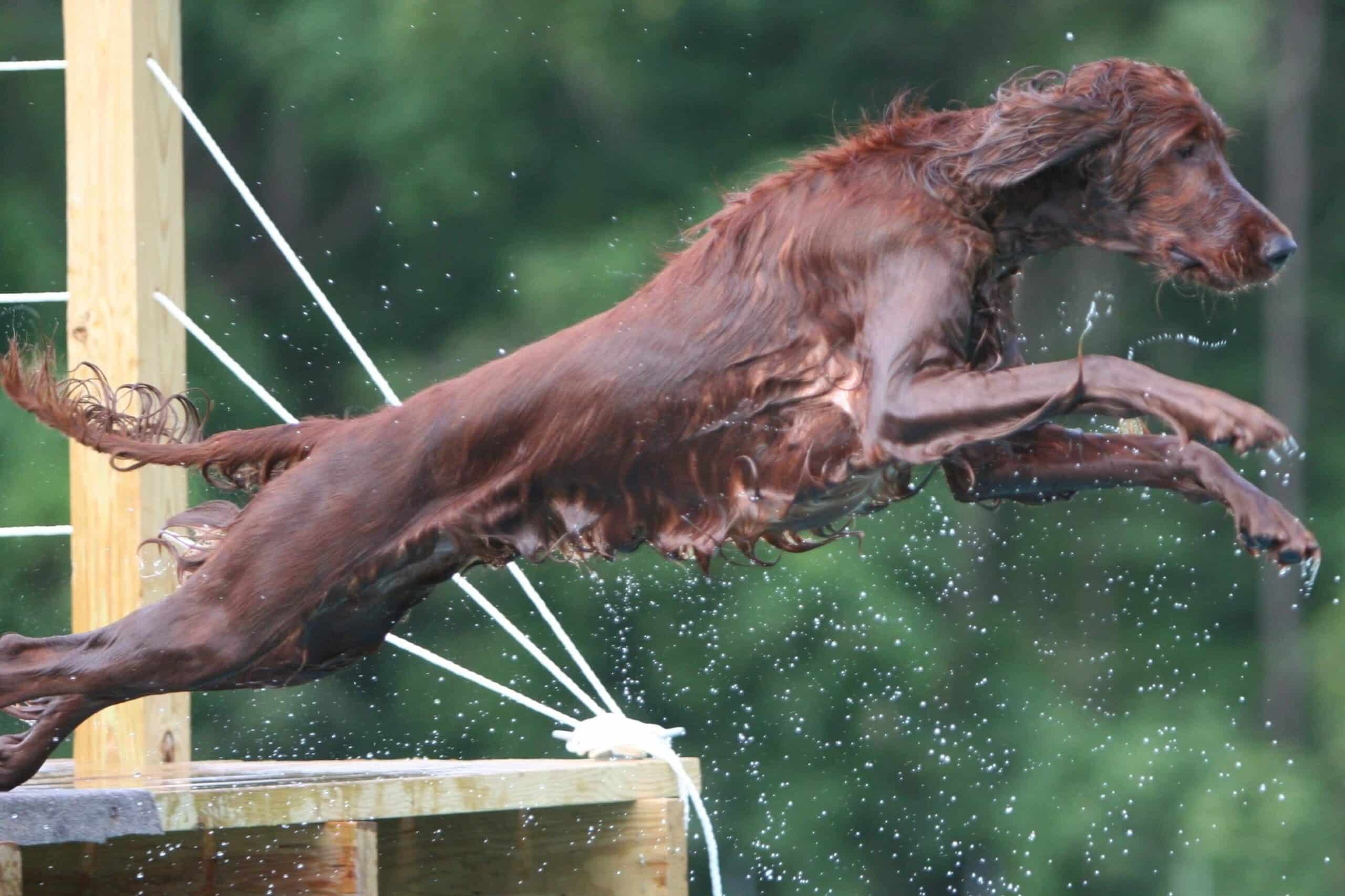
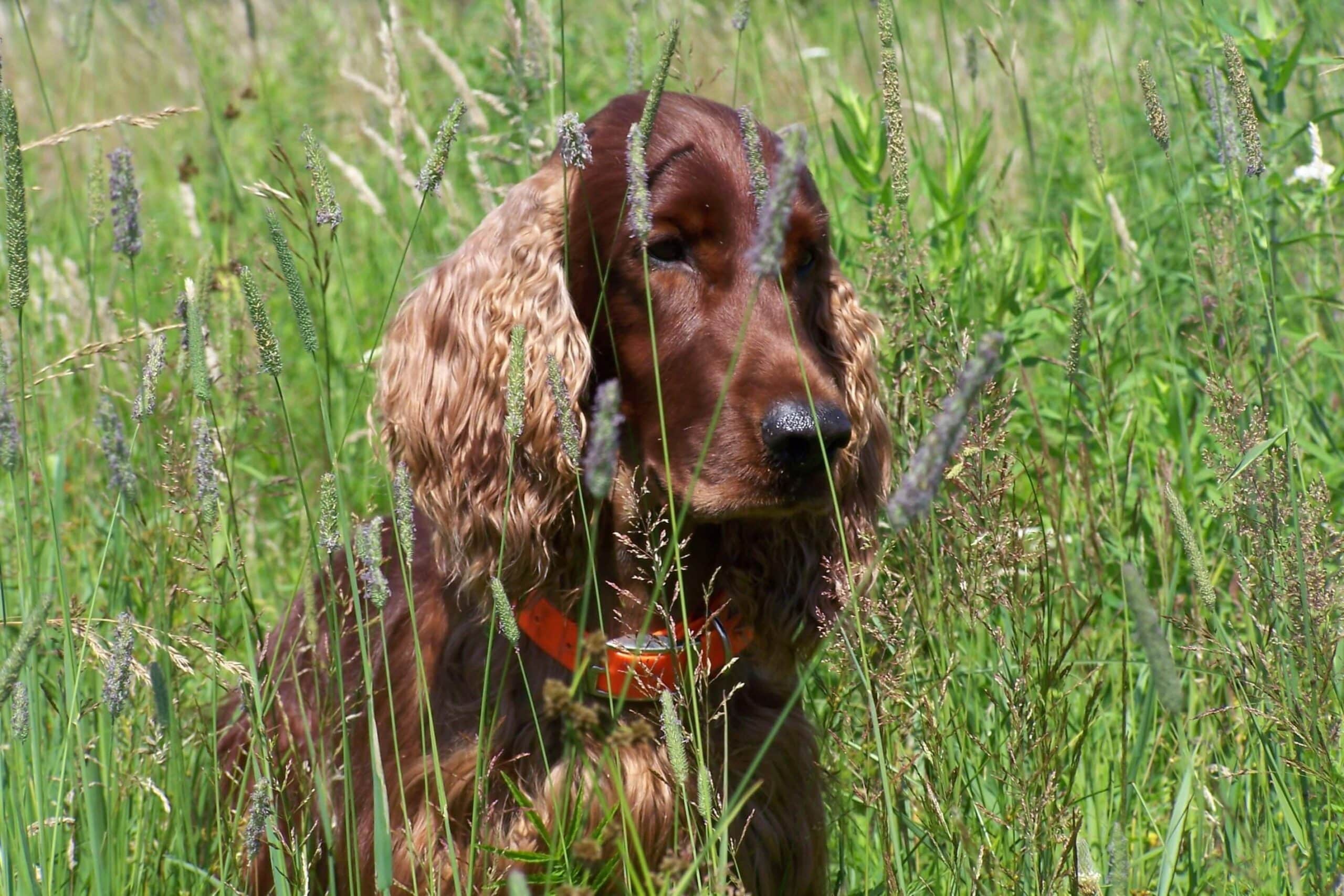

The Irish Setter is a friendly, active, and sweet-natured dog recognized by its flashy red coat and for its undeniable gracefulness. The breed was originally created in Ireland to work on farms and for hunting as a bird dog, although it is not often seen in the field today alongside similar pointing breeds. The Irishman’s hunting skills, however, remain strong and individual dogs still perform their historic role as a hunter’s companion. A good Irish Setter is usually slow to mature and will act like a puppy for several years, making it a great playmate for kids as well as a trusted partner for many years.
Sporting Group
25-27 Inches
60-70 Pounds
12-15 Years
| Country of Origin | Ireland |
|---|---|
| Bred For | Finding, Setting & Retrieving Birds, Companionship |
| Known For | Grace, Red Coat, Swiftness |
| Popularity | Moderate |
| Temperament | Active, Outgoing, Sweet-natured |
| Activities | Hunting, Running, Hiking, Bikejoring, Therapy Dog, Conformation Shows, Dog Sports |
The Irish Setter was bred to locate birds by using its keen sense of smell. The name “setter” represents the action this breed takes when it finds a bird; it “sets” down on its belly in the direction of the hidden bird and remains still until the hunter arrives. Prior to the development of the firearm, setters collaborated with trained falcons and hunters using nets to capture the birds. Today’s setters operate as gundogs alongside hunters with rifles.
This breed was likely developed in the 1800s by Irish sportsmen looking to develop a sleek and rangy bird dog that could move swiftly and cover a large area of land. Irish Setters are probably the result of combining English Setters and Gordon Setters as well as spaniels and pointers.
The original Irish Setters were occasionally referred to as red spaniels, or modder rhu, which is Gaelic for “red dog.” Instead of the solid dark red seen in the breed today, they were frequently red and white in color. Some of the so-called “shower of hail” canines had red coats with little white dots all over the body.
In the field, the breed developed a reputation as an energetic but resourceful worker. And since the inception of dog shows in the 1870s, the breed has also enjoyed success in the show ring due to its alluring appearance and rollicking gait.
The most well-known Irish Setter of all time, however, was a fictional creation—Big Red, the protagonist of Jim Kjelgaard’s 1945 book of the same name. King Timahoe, an Irish Setter owned by President Richard Nixon, was named after a little hamlet in Ireland, the country of the president’s ancestry.
In terms of height, adult male Irish Setters measure around 27 inches tall at the shoulder, with females typically measuring around 25 inches tall. Males can weigh up to 70 pounds, while females generally weigh about 60 pounds.
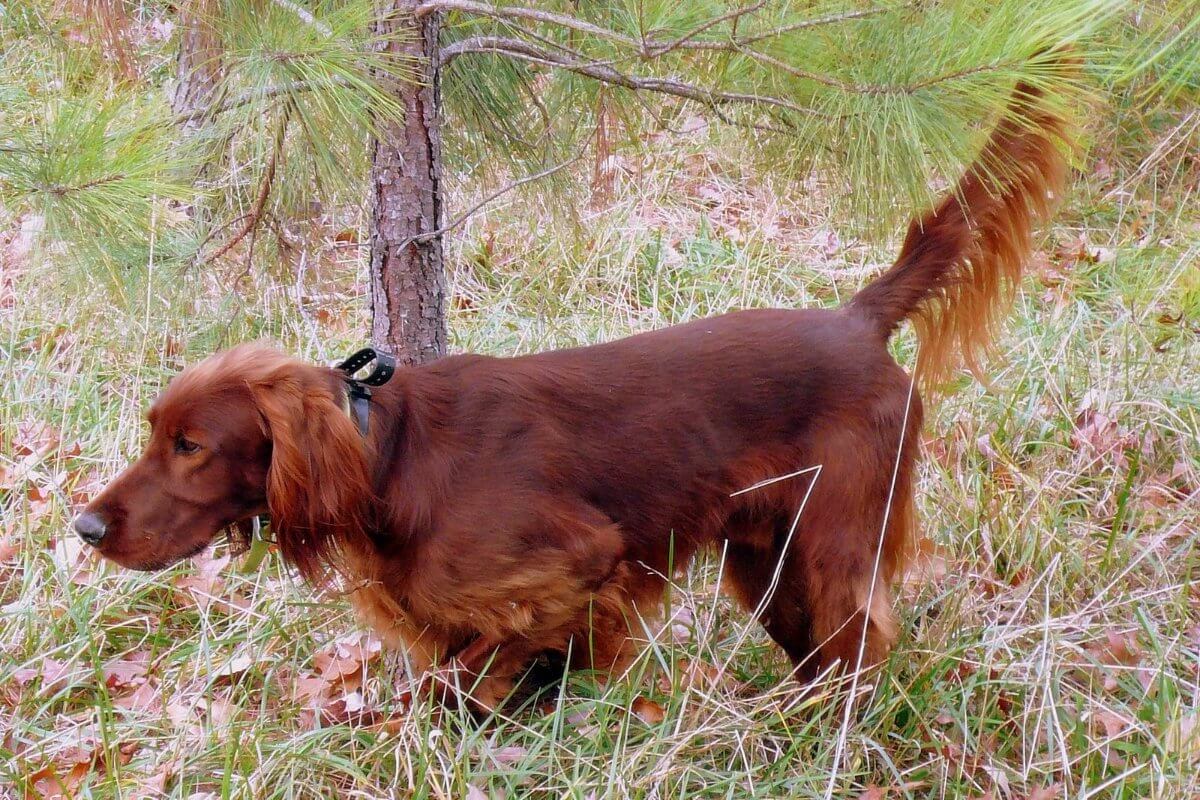
The Irish Setter displays a racy and athletic figure. The breed’s body is beautifully proportioned, with shoulders fine at the withers, deep, and sloping. The chest should be as deep as possible and relatively narrow in front. The ribs are nicely sprung, giving plenty of lung space that’s needed for a far-ranging field dog. Loins are muscular and slightly arched, and the hindquarters are broad and robust.
Texture: The coat of the Irish Setter is short and fine on the head and forelegs. On the other parts of the body, the coat is of moderate length, flat, straight, and free of curl or wave. A pleasing fringe of hair (feathering) exists on the chest, brisket, belly, backs of the forelegs and thighs, and on the tail.
| Standard Color | |
|---|---|
| Chestnut | ee |
| Mahogany | ee |
| Red | ee |
A Note About Color: The Irish Setter can exhibit a small amount of white on the throat, chest, or toes. A narrow, centered streak of white on the head is also acceptable; however, black hairs are not acceptable.
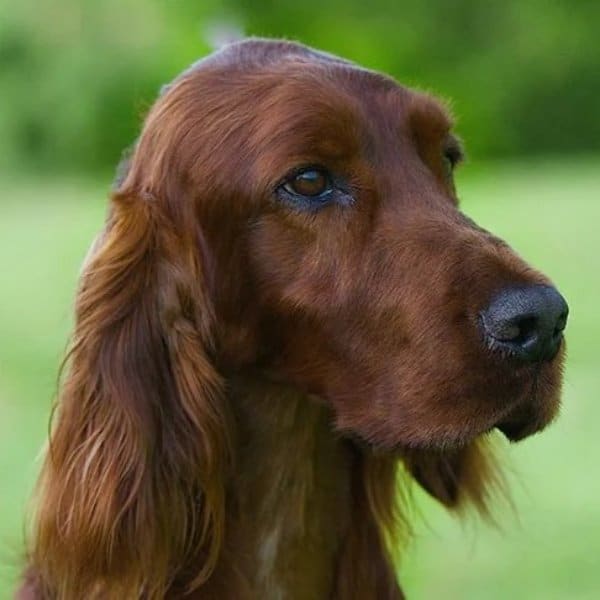
The Irish Setter’s tail is one of the breed’s most beautiful and attractive features. Other than being just plain beautiful, the tail represents the most expressive part of this setter’s structure by showing the happy and outgoing nature of the breed. The tail should flow naturally as an extension of the sloping topline. Tail carriage is ideally close to being level with, or below, the back. In the field, the movement of the tail shows the dog’s current interest. When at full speed, the tail of an Irish Setter acts as a rudder and a flag. While on point, the tail is rigid with intensity.
The Irish Setter easily catches the eye with its gorgeous color, athletic figure, and beautiful head and tail. This breed is not simply beautiful, however, it is also very intelligent, friendly, and mischievous. These qualities make the breed a very likable choice for many people, but owning this breed requires a lot of responsibilities since it is not a dog that’s suitable for every type of home environment.
The Irish Setter is typically a healthy breed of dog, known for its energetic nature and friendly disposition. However, like all breeds and mixed breeds, the Irish Setter can be susceptible to specific health conditions. Prospective owners should be aware of these potential issues and work closely with a trusted breeder and veterinarian to ensure the Irish Setter maintains optimal health throughout its life.
Lifespan: The average lifespan of an Irish Setter ranges between 12 to 15 years. With proper care, regular check-ups, and a balanced diet, many can enjoy a life filled with activity and affection well within, and sometimes beyond, this range.
Although generally a healthy breed, some Irish Setters can be prone to certain health conditions, including:
Regular veterinary check-ups are essential for early detection of these and other potential health issues. Along with general wellness exams, specific tests for the eyes, hips, elbows, and heart are recommended to ensure that an Irish Setter remains in the best possible health.

The Irish Setter displays a personality that is often described as rollicking, sweet-tempered, and affectionate. The breed is also known for its swiftness. With it being a high-energy breed, it is important to ensure every Irish Setter is provided with a safe environment, such as a large fenced yard.
Intelligence is one of the breed’s most appealing characteristics; however, the Irish Setter tends to be a really mischievous and independent breed, so the training requires a lot of patience and consistency. Like any other breed, the Irish Setter needs early socialization and exposure to different people, sounds, sights, and experiences while young.
An Irish Setter is a slow-maturing breed. Its puppylike enthusiasm will be displayed for several years, which makes the breed a perfect companion for active, older children. This breed can, however, be overwhelming for toddlers.
Overall, this breed is really friendly. It doesn’t matter if kids, adults, or even other dogs are in question, the Irish Setter will welcome one and all and initiate play. The breed can also be quite sensitive, so these dogs don’t really enjoy being alone for too long. They thrive on companionship and can become quite attached to their families. Although not being much of a guard dog, the breed is known for stepping in to protect its family if needed.
The Irish Setter is known as a canine athlete, so these dogs need to be fed a high-quality, balanced diet full of protein to support the breed’s energy needs and overall health. Protein sources such as chicken, lamb, and beef are essential for the dog’s growth and development. They also supply the nutrients required to increase amino acid production, which is essential for the development and maintenance of healthy skin, tendons, muscles, hair, nails, and ligaments. Furthermore, without high-quality protein, a dog may be deficient in nutrients required for appropriate hormone production.
When it comes to feeding, it is important to measure portions according to the weight, age, and energy level of the dog. The recommended daily amount is 2 to 3 cups, divided into two meals, which helps to keep sugar levels stable while avoiding potential bloat.
Irish Setter puppies should be fed up to four times a day. Puppies usually require more food than adults do in order to grow up strong and healthy. During the first six months of their lives, some puppies may require up to three times the amount of food as an adult Irish Setter, just to maintain their energy and growth.
Meat, bone, offal, and a small amount of plant sources are all significant components of an Irish Setter’s diet, each providing highly useful vitamins and minerals. A raw meal contains 70% moisture/water on average, which helps to keep the Irish Setter hydrated.
The Irish Setter is known for its friendly and outgoing disposition, which often translates into an eager-to-please attitude during training sessions. However, novice dog owners should be aware that this breed is also characterized by its high energy and a sometimes mischievous nature, which can occasionally make training a bit of a challenge.
Irish Setters are intelligent and can grasp commands quickly, but their playful and independent spirit sometimes comes into play, leading them to be easily distracted. Early socialization and consistent training from a young age are essential for the Irish Setter. Positive reinforcement techniques, such as treats and praise, tend to work best with this breed.
One potential challenge when training an Irish Setter is its tendency to bark. While these dogs aren’t excessive barkers, they can be vocal when bored or left alone for extended periods. It’s essential to address any excessive barking behavior early on and provide them with enough mental and physical stimulation as prevention measures.
Regarding their intelligence, Irish Setters are quick learners. However, their intelligence also means they can be a bit headstrong, so it’s crucial for owners of these dogs to establish themselves as “top dog” early on. This will help to make training more straightforward and ensure commands are easily understood and readily followed.
Wanderlust potential is something to be aware of with the Irish Setter. The breed is known to have a somewhat strong prey drive, owing to its hunting lineage. This means an Irish Setter might chase after small animals or wander off if it catches an enticing scent. A securely fenced yard and a reliable recall command are vital for this breed.

The Irish Setter is a bird dog and, like any other breed of that kind, it needs a lot of exercise since it is a high-energy dog. The breed is known for its active and playful nature, so any kind of exercise is good for it as long as a large, fenced yard or safe outdoor space is provided.
| Energy Level | High |
|---|---|
| Exercise Requirements | 2 Hours/Day (Minimum), Daily Walks, Regular Exercise, Vigorous Running, Playing with Another Dog, Mental Stimulation |
The breed depends on getting a sufficient amount of exercise daily, and the recommended amount is 1 to 2 hours per day. Healthy adults aged 2 to 7 should be given closer to 2 hours of walking each day, although it’s best to split this time into two different sessions. If this is not possible, the Irish Setters will gladly enjoy one long, playful session.
Other than just going for a walk, the Irish Setter needs a lot of different activities and games to stay happy. With their friendly nature, these dogs enjoy being with their people and doing fun activities together. Playing fetch is one of many activities that will engage both dog and handler. And most Irish Setters are naturally attracted to water, so swimming sessions are a great way to burn energy, especially if the dog is recovering from injury.
Mental stimulation is also an important part of the Irish Setter’s daily exercise regimen. Without it, the breed can be prone to a few bad behaviors. Since they are known for their intelligence, puzzle toys are a great choice for Irish Setters. However, the most important tool of all is plenty of socialization.
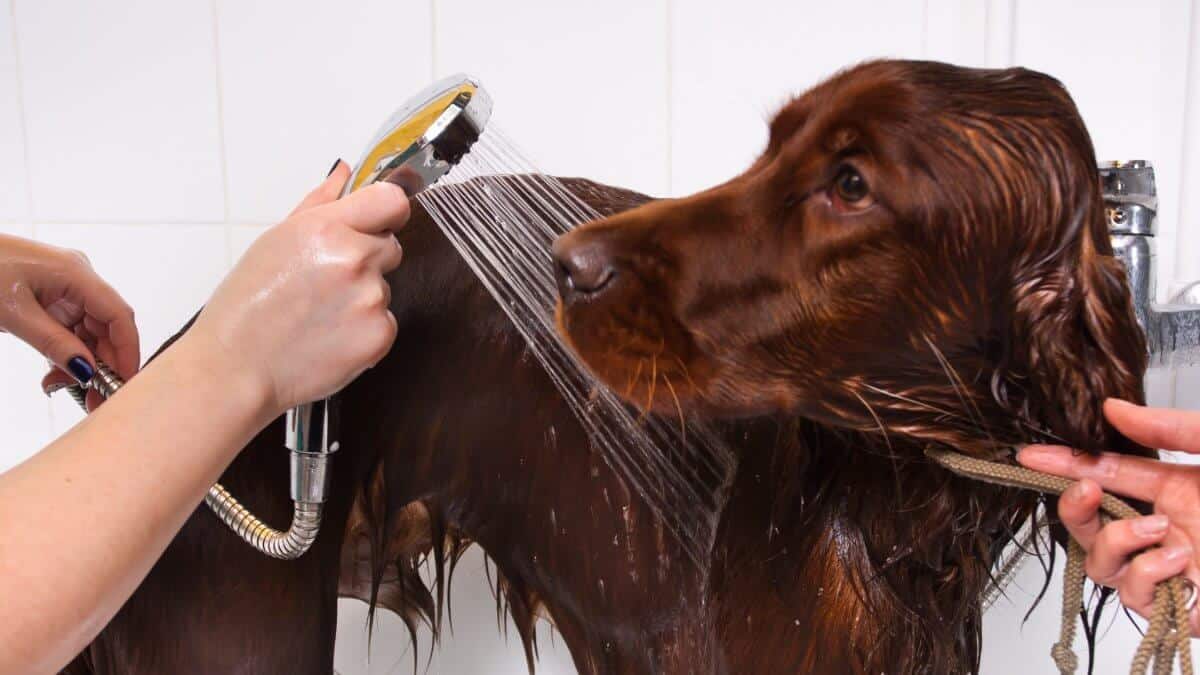
One of the traits that contributes to the Irish Setter’s reputation as one of the most beautiful breeds of dog in the world is its stunning coat. The burnished mahogany or rich chestnut red coat is short and fine on the head and forelegs, relatively long and straight on the remainder of the body, with long, silky feathering on specific parts of the body, most notably the tail.
| Coat Type | Short and Fine on Head, Ears, and Legs; Moderate Length and Flat on the Body |
|---|---|
| Grooming Requirements | Daily Combing, Weekly Brushing, Occasional Bathing, Routine Ear Cleaning, Periodic Nail Trimming, Regular Tooth Brushing |
Irish Setters should be brushed at least every other day to keep their coats shiny and tangle-free. Bathing is not essential more than a couple of times a year, as long as it’s regularly brushed. This breed will need bathing only if the dog rolls in something dirty and stinky.
Ear infections are not uncommon in breeds with pendant, or hanging, ears. Therefore, it is important to check the Irish Setter’s ears once a week and clean them with a cotton ball soaked with a veterinarian-recommended cleanser. Never insert cotton swabs or anything else into the ear canal as this may cause injury. If the inside of an Irish Setter’s ear smells unpleasant, seems red or sensitive, or the dog shakes his head or scratches at his ear regularly, the dog may have an ear infection.
The Irish Setter’s teeth should be brushed at least twice a week to remove plaque and bacteria. Brushing twice a day is even preferable to avoid gum disease and foul breath. If the dog doesn’t naturally wear down its nails, they should be trimmed once or twice a month. Nails are too long if they can be heard clicking on the floor. Short, carefully trimmed nails maintain the feet in good shape and guard against scratches on your legs when your Irish Setter rushes up to greet someone.
The Irish Setter can be one of the high-maintenance breeds when it comes to grooming, so patience is key. It’s important to always remember that grooming is not just about keeping the dog beautiful. It is also about monitoring the dog’s overall health and general well-being.
Living with an Irish Setter is a really pleasant experience as long as the proper care is provided. With it being a playful, active, and friendly breed, it needs a lot of outer space to run around. These dogs don’t like being left alone, so it’s essential for them to live indoors with their owners. Living with an Irish Setter means having a happy companion around at all times.
Irish Setters are large dogs and, with their high energy, their need for exercise is a little larger than the needs of many other dogs. When at home, the breed should have a large fenced yard to run around in between walks around the neighborhood. Its playful and happy nature makes it perfect company for energetic kids, although it’s important to always keep in mind that Irish Setters can be too much for toddlers who can be unintentionally bowled over.
There is no living creature that the Irish Setter does not find a friendly companion. Little kids, strangers, other dogs, and even cats are all suitable playmates. This breed can get along with anyone, and with that in mind, it makes the perfect pet for many people around the world.
Overall, the Irish Setter is highly adaptable. With it having been bred for the inclement Irish weather, this breed can easily handle cold and rainy weather; however, it can adapt to warm weather equally well. Still, if you live somewhere warm, it’s crucial to provide the dog plenty of shade or access to swimming.

Irish Setters puppies have wonderful personalities. They are curious and playful, and they have no problem approaching strangers and letting people hold them. However, they can be a little rambunctious towards children. When choosing a puppy, always consider the breeder’s experience with this all-important decision.
Before bringing home an Irish Setter puppy, make sure to ensure a safe and nurturing environment. Since the breed is curious and playful from a young age, constant supervision is required to keep Irish Setter pups from harm. Providing them with toys will also help with their teething needs.
Puppies require different types of experiences than do adult dogs. Puppy kindergarten is a fantastic opportunity for puppies between the ages of 8 weeks and 4 months to obtain training, socialization, and exercise. They also enjoy 15 to 20 minutes of playtime in the yard each morning and evening. From 4 to 6 months of age, daily half-mile walks, weekly obedience training, and periods of free-play will all take care of their exercise needs.
For an Irish Setter puppy, crate training is necessary. This breed is extremely inquisitive and will inspect everything with its mouth. When no one is home to monitor the puppy, a crate will assist with keeping your puppy and your belongings safe and secure.
An Irish Setter puppy and its owner form a unique bond. It’s important to spend quality time fostering this bond, whether that is through engaging activities, instructive lessons, or tender cuddle time. This closeness not only promotes trust, it also deepens the bond of the human-canine relationship.
Regular veterinary check-ups are crucial during the first year of life. Vaccinations, deworming, and basic health checks should be performed at this time to ensure the puppy is growing normally.
Important aspects of puppy care include basic training and socialization. Training puppies at an early stage will allow them to grow into well-behaved adults. Early and consistent socialization will also instill confidence and reduce the chances of fear or misbehavior later in life.
Irish Setters are born to run, so their activities must contain a lot of it. Over the years, this breed has been involved in a variety of activities and dog sports, showcasing the breed’s diverse skill set.
The Irish Setter is recognized by the world’s leading registries and kennel organizations, which categorize the breed into a specific Group based on its unique characteristics. This breed is recognized worldwide under the following Group designations:
| Organization | Group Designation |
|---|---|
| AKC (American Kennel Club) | Sporting |
| UKC (United Kennel Club) | Gun Dog |
| CKC (Canadian Kennel Club) | Sporting Dogs |
| ANKC (Australian National Kennel Council) | Gun Dogs |
| RKC (The Royal Kennel Club) | Gundog |
| FCI (Fédération Cynologique Internationale) | Group 7: Pointing Dogs; Section 2: British and Irish Pointers and Setters |
The ideal Irish Setter is described by a Breed Standard that is approved by each of the world’s leading registries and kennel organizations. The Breed Standards for this breed may be found in the following links:
| Organization | Breed Standard |
|---|---|
| American Kennel Club | AKC Irish Setter Breed Standard |
| United Kennel Club | UKC Irish Setter Breed Standard |
| Canadian Kennel Club | CKC Irish Setter Breed Standard |
| Australian National Kennel Council | ANKC Irish Setter Breed Standard |
| The Royal Kennel Club | RKC Irish Setter Breed Standard |
| Fédération Cynologique Internationale | FCI Irish Setter Breed Standard |
Irish Setter clubs are essential for maintaining the breed’s written Standards, encouraging ethical breeding practices, and creating a supportive environment for both breeders and devotees. These clubs frequently act as focal points for activities, activism, and education related to the Irish Setter breed.
The Irish Setter Club of America operates under the broader umbrella of the American Kennel Club. It promotes responsible breeding, the exhibition of Irish Setters in Conformation Shows and Field Trials, as well as in various dog sports. The club offers resources, organizes events, and supports Irish Setter-related health research.
The Irish Setter Club of Canada works under the wing of the Canadian Kennel Club. It is dedicated to the betterment of the breed through education, breed health, and ethical breeding practices.
In the United Kingdom, the Irish Setters Breeders Club offers everything a breed club should, such as promoting the Breed Standard, offering useful resources to exhibitors and field enthusiasts, and promoting responsible breeding standards. The club was founded in 1938 and is said to have the largest membership of any UK breed club.
Irish Setter enthusiasts have access to a variety of information and the opportunity to interact with people who share their passion for this famous breed by joining or participating in these clubs.
Irish Setters are among the most adored and friendly dog breeds in the world, but they are not immune to the difficulties that many dogs can come across, such as abandonment or abuse. Thankfully, a number of devoted Irish Setter rescue groups put in endless hours to make sure every dog in need is placed in a caring home.
Irish Setter Club of America Rescue, in fact, is a volunteer group of ISCA members who work hard to ensure a new home for abandoned or neglected Irish Setters. In addition, the organization’s aim is to educate people about the qualities and usefulness of the breed.
Irish Setter Club of Canada Rescue is the national breed organization that is affiliated with the Canadian Kennel Club. Through the years, the group has been successful in placing many Irish Setters in new homes, highlighting the significance of finding just the right dog-owner match.
The Independent Irish Setter Rescue & Rehome group operates in the United Kingdom. It is a small organization formed by Irish Setters enthusiasts who offer shelter to Irish Setters whose owners are no longer capable of taking care of them.
Yes, the Irish Setter is considered a good family dog due to its friendly and sweet nature. The breed is good with children, gentle and patient, and it can make a great playmate for children of all ages.
Irish Setters are affectionate and love their family with all they have. Due to this affection, and owing to their alert nature and keen sense of smell, they can also make excellent watchdogs.
The Irish Setters are social and friendly dogs. Therefore, they don’t like being left alone for too long since they can develop separation anxiety or become destructive. With this in mind, it is better not to leave them alone all day.
No, Irish Setters don’t typically bark often. However, they will alert if something is happening, though constant barking is not usually an issue with this breed.
Even though they don’t bark a lot, Irish Setter can nevertheless be pretty vocal. They sometimes like to “talk” to people as a way of expressing their feelings and desires.
Irish Setters mostly shed during the spring and autumn. During the rest of the year, however, shedding is usually moderate and can be managed with regular brushing.
Irish Setters are considered moderate to high maintenance. Their need for grooming is relatively low, but their desire for exercise and attention may be more than some homes are able (or willing) to provide.

Explore the Irish Setter’s dual nature excelling in show and field, highlighting the breed’s resurgence in Dual Championship titles.
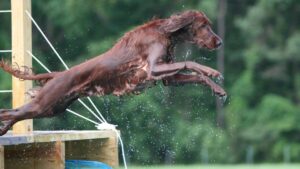
Learn about judging the Irish Setter, focusing on balance and adherence to the breed standard that underscores its sporting dog heritage.

Laura Heidrich of Laurent Kennel shares insights from decades breeding champion Cocker Spaniels, Pointers & Irish Setters.

Patty Fanelli of Kinloch Irish Setters shares her decades-long dedication to breeding elegant, spirited champions with timeless appeal.

Laura Heidrich is the breeder behind Laurent Cocker Spaniels, Pointers & Irish Setters. Read about the kennel’s beginnings, and much more!
The best way to ensure a long and happy relationship with a purebred dog is to purchase one from a responsible breeder. Not sure where to begin?
Contact the National Parent Club’s Breeder Referral Program, which is listed on the AKC Breeder Referral Contacts page.
